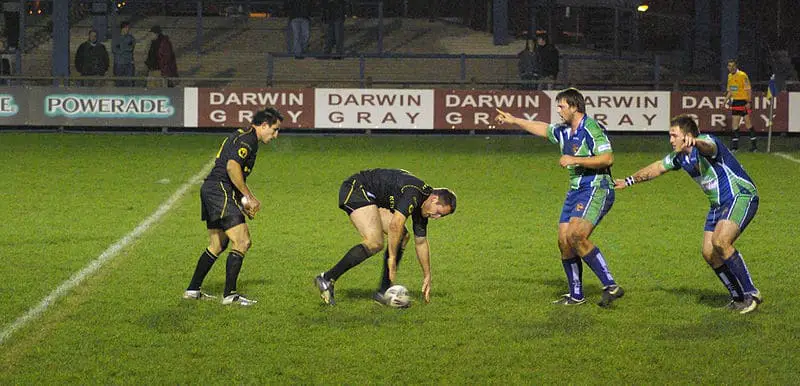I have still got two stud marks down the side of my rib cage where an opposition forward stamped all over me during a ruck in an U15s game of rugby. So, what are rucks and why are they so special?
A ruck is when a player is tackled to the ground holding the ball, and supporting players attempt to drive opposition players away from the ball exposing it on their side of the ruck. These players must stay on their feet, join from the back foot, and must not attempt to pull it down.
More than one player can join a ruck but they must join alongside the last player in the ruck and they must bind onto them simultaneously. Heads and shoulders must never go below the height of a player’s hips.
Players can use their feet to move the ball back on their side but stamping on or, raking of a player’s body is not allowed.
When a ruck forms it creates an offside line at the back foot of the hindmost player in the ruck. All the players not involved in the ruck must stay on or behind this line or risk giving away a penalty.
What do rugby rucks do?
Rucks provide a way for teams to compete for the ball following a tackle to the ground. They ensure there is a continued fair competition for the ball at all times.
Rucks also allow teams to recycle the ball faster than if they created a maul and so are useful for teams wanting to use their backs to run more.
A team that wants to play a rucking style of game will pick players that are lighter and fitter than teams that want to play a mauling style. This will mean that their players can get to the rucks faster and secure the ball before their heavier opponents even arrive for the ball.
This was the tactic employed by Japan when they beat their heavier opponents Scotland at the 2019 Rugby World Cup. A perfect example of a quick ruck ball being utilised well.
Rucking rugby also suits teams that play in warmer climates on harder, faster grounds as players can move over the ground more easily and handle the ball better thus suiting a quick rucking style of play.
On muddier surfaces with heavier forward packs, such as those found in the English premiership in winter, teams may base their entire attacking game around the rolling maul and scrum.
For example, Exeter in the early 2020s were almost unstoppable at maul time and won trophies off the back of this.
Recommended reading: Basic Rules of the Scrum (Explainer)
What is the difference between a ruck, a maul and a scrum?
A ruck occurs during open play when a player is tackled or falls to the ground. The ensuing competition to drive over the top of the ball, by players from either side, is known as a ruck. For a maul, the tackled player manages to stay on their feet and other players join them to wrestle for the ball.
A scrum on the other hand is not from open play, it is a set-piece, and a way of restarting the game usually following a knock-on. The image below clearly shows the difference between the three. From left to right: a ruck, a maul and a scrum.

Check out here: The Basic Rules of the Maul
Can you pull a player through a ruck?
Pulling a player through a ruck is considered to be dangerous play and will be penalised by the referee as such. You can only drive players back over the ball and you must attempt to wrap your arms around your opponent as you do so.
If a player charges into a ruck and does not attempt to grasp an opponent and instead hits with a shoulder charge then they may very well receive a yellow card and if there is contact to the head area then a red card will ensue.
This is sometimes known as a ‘chicken wing’ when the player charging into the ruck tucks their arms by their side and leads with their shoulder.
These can be very dangerous and there have been a plethora of sendings off in recent years in high profile games as referees clamp down on this area.
Suggested reading: Can You get Up After Being Tackled In Rugby?
Can your hands touch the ground during a ruck?
Players are not allowed to touch the ground, or other tackled players on the ground to support their body weight. Leaning on a tackled player with the knees is also not allowed.
It is very difficult for the referee to judge whether a player has used a tackled player’s body to support their body weight as they jackal for the ball, or whether they have maintained an upright position through leg strength alone and many a controversial penalty is given because of this.
‘Hands in the ruck’ is a common phrase you will hear referees and commentators use. Essentially, if a player believes they can claw the ball back onto their side by using their hands and not be seen by the referee they often attempt to do so.
However, if the referee notices this then they will award a penalty, and repeated infringements could lead to a yellow card.
Check out: Which Rugby Position Runs Most?
Who can touch the ball in a ruck?
The only player who can touch a ball in the ruck is the ball carrier. This person is allowed one movement to place the ball back on their side. Players competing for the ball by trying to drive opponents backward cannot touch the ball, ground, or tackled player to support their body weight.
Why are there no rucks in rugby league?
There are no rucks or mauls in rugby league, they have their own system called the ‘play the ball’. This system guarantees that the side in possession of the ball keeps possession and is often thought to maintain a quicker tempo to the game than which rucks and mauls allow.
The player that is tackled simply needs to hold onto the ball as they hit the ground. After the tackler gets up off the floor and moves away the tackled player can stand up and roll the ball with their foot to a player standing behind them waiting to play the ball, usually pass it away as can be seen in the picture below:

Rugby league splintered away from rugby union many years ago to become a professional game much earlier than union. Part of being a professional game is attracting crowds and being entertaining.
Eliminating the ruck and the maul was, therefore, an obvious first step in promoting a more attractive style of rugby although it took away the competitive element whilst he ball is recycled.
This is the main difference between the two sports, rugby union is all about competition for the ball at all times through scrum, ruck, maul, open play and lineout, whereas rugby league takes away that major element in favour of a more continuous game.
The ruck remains a treasured part of the game in rugby union and long may this continue.
Recommended reading: The Basic Rules of the Lineout Explained
Image Credits
Ruck, 29 August 2015, 18:46:55 Clément Bucco-Lechat, CC BY-SA 3.0, via Wikimedia Commons
